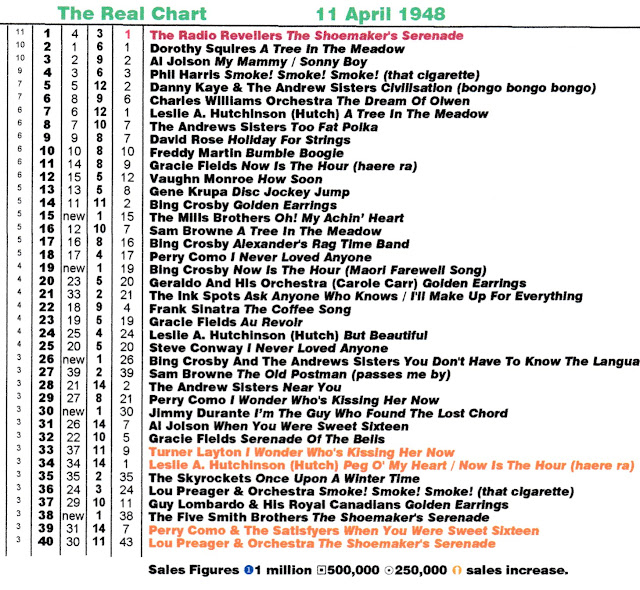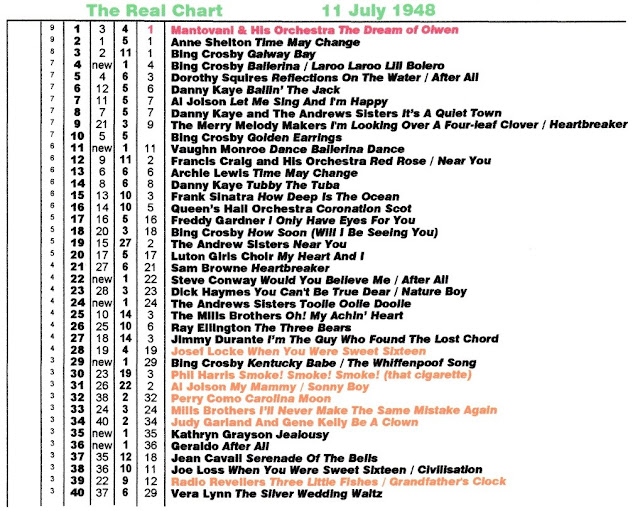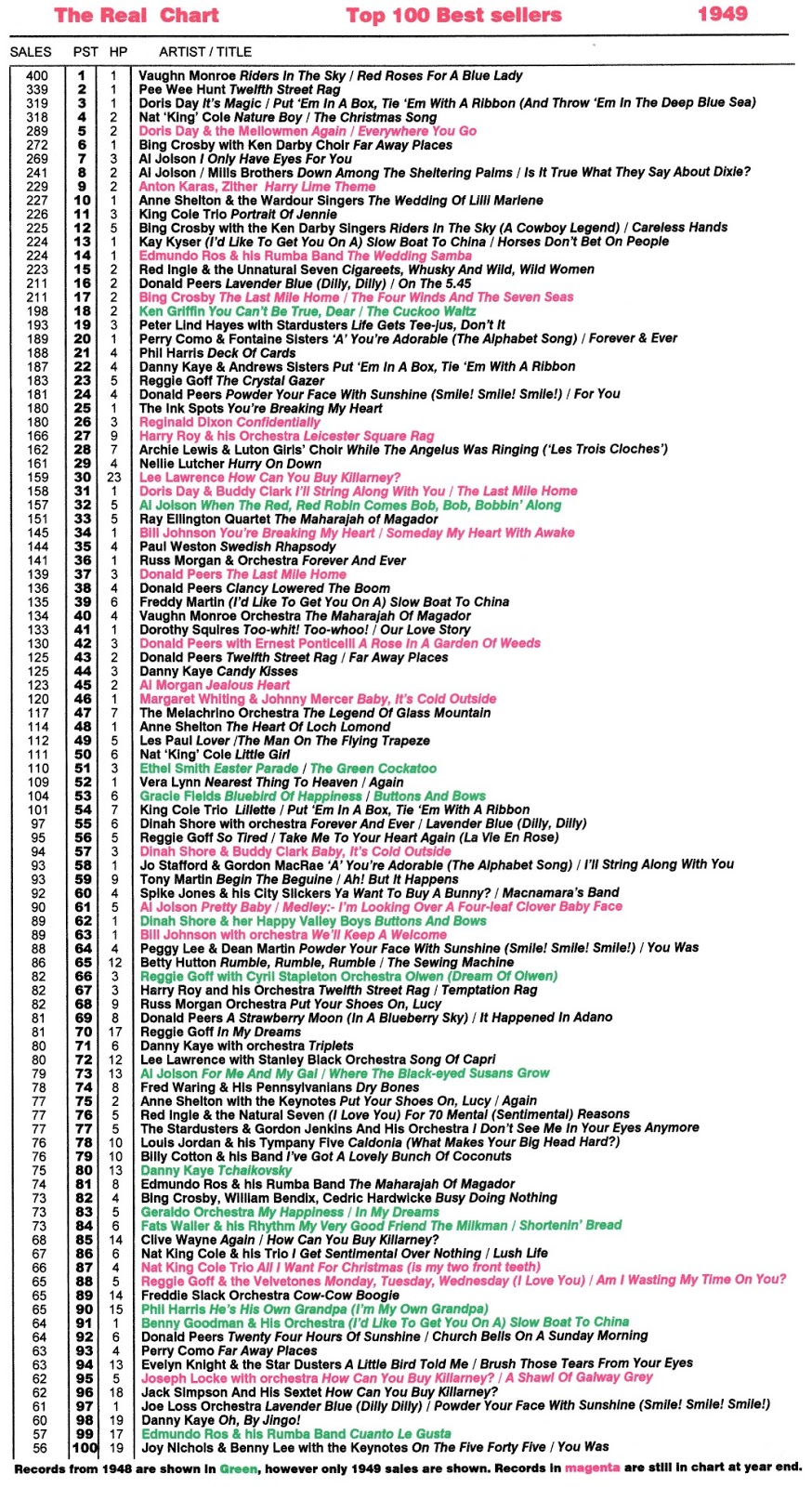All the top 40 charts from the first Real Chart in January 1948 to the end of 1949 will eventually be posted here, including the sales figures!... For now we have the first ever Real Chart plus all the rest from 1948. Below them I have started the 1949 charts and these will be posted in batches as soon as I can sort them out. They will not be going up in real time like in the classic charts for 1981. They should be completed long before Christmas. The full charts for 1948 can be also downloaded from the link below. Plus the incomplete charts for 1949 which are present and correct, but do not have the sales columns for the run on from 1948 and the year's sales column. Except the very first chart. The columns are however present and readers could add up the totals for each record. There is however the full top 100 best sellers list at the end. If any reader has the Page Plus Desk Top Publishing Software I can e-mail them the original 1949 file if they wish to add the sales to the document. It would save me a lot of work too! Post below and if you don't want your e-mail to be public mark it so. All messages come only to me for approval first, any marked private will not be posted.
The Real Chart 1948 PDF
I'm pleased to announce that a blog reader called John Kobylecky has spent hours of time adding up the record sales of 1948 and has sent me the best selling singles list he has produced. It includes a list of both sides of the records and the Record Label information. As well as some interesting insights of the record scene in 1948. I would like to thank John for his hard work on this. Plus for his help with the record release information he sent me. Without which it would be very difficult to find the artist and titles to have made these charts. John seems to be very informed on the music business of the years 1946 to 1952 and if you have any questions about the best sellers chart or that period, I'm certain he will be glad to answer them. His email address can be found in the PDF file below.
He's told me that when the 1949 charts are finished he will do the same with them. Cheers John!!
The first chart has sales figures in thousands then hundreds. The second chart has the total sales and like the first, the week's sales in thousands and hundreds. However since it takes even longer to add them all up and put in the hundreds, from the third chart onwards the sales figures only show the current week plus only show sales in thousands. The Gold sales increase arrows are not always included in each chart too and there are none later! Even though the sales totals are not totalled up, I have done some rough calculations on some and some have just scrapped past the 250,000 mark (see 19/12/48). Of course if any readers want to add the figures up they can do so and confirm this. (see above) After March I have removed the sales information tag at the bottom of the chart, as none of the charts carry the sales information. There is an error on the weeks at number one on Galway Bay, but this gets corrected in later charts. Some of the titles and artists names have been shortened due to the space constraint of the chart layout. The reason for this is that many records credited orchestras, vocalists and other persons, more greatly than they tend to do these days. This means that the record credit would take up several lines and cause layout problems. Records back then were not generally issued weekly as they are now, but at the start of each month. From what I can tell this system of monthly releases continued right up to the early sixties Even so some records continued to enter as the month went on as the public found out about them. These charts compare well to both the Sheet Music Charts and the publishers lists used in the book Missing Hits 1940-1952. There are some variations with the Missing Hits book. But this is down to the fact that the original compiler of the charts in the book had a bad habit of using the wrong side of the record. In some cases I have listed the correct "A" side in the Real Charts. These often tie in with what was in the Sheet Music Chart's, whereas those titles listed in Missing Hits are not found in the Sheet Music Chart. The big difference with the Missing Hits charts is that the top 40 doesn't get loads of new hits at the start of each month and then few in-between. This is because the public were a bit slower at getting to like records. The Sheet Music Charts were later broadcast by Radio Luxemburg. However these were not sale charts of records. In some cases that station was broadcasting a record that you couldn't buy in a UK shop, unless the shop imported it from the USA. So if you had heard that record at the time and went to a record dealer to buy it you would have got the version that was in the shop not the one played on Luxemburg. Keep a look out for the Devil's Gallop which was the theme to the BBC Radio series Dick Barton Special Agent, which of course never featured in the Sheet Music charts. And the first showing of Bing's White Christmas which of course had been more popular during the war. It might also interest readers to know that the first chart has the first instance of the public buying a record shortly after the artist's death. For Richard Tauber at number 6 had died in the week's that this chart covered. Tauber's record had been released in November of 1947, but there is no reason why it should be in the top ten by this period, other than the public wanting to purchase the record following his death.
The video of the first number one

The Real Charts 1949
Over the next few months I will post all the top charts from 1949 below. They will come in batches as fast as I can do them.
The first chart includes some rough working out of the sales totals of some of the records, but the rest of them have been left blank! I have left the explanation box below the charts, as I have worked out which records did increase it sales that week, though the sales symbols apart from the first chart are not used again. I will continue to show sales increases for all the other charts. Again all records dropping out are indicated by the use of the orange colour. Number One records are shown first as red, then Blue. Any other colour means it has returned to the top spot. Blank spaces on the highest position are due to the fact I have not checked were the record dropped out, but readers can simply look back at these charts previous to it and quickly tell what it got to first time around.
The title error on the Al Jolson entry in the February charts which credited I Only Have Eyes For You when it was: Down Among The Sheltering Palms, has now been corrected.






































































































Wonderful stuff, keep 'em coming! Very much appreciated.
ReplyDelete